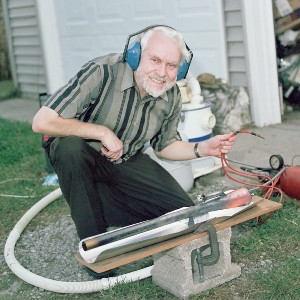|
The Non-Mathematician's Guide To
Basic Valveless Pulsejet Theory
© 2008 Larry Cottrill
by Larry Cottrill 25 Sep 2008
All jet engines are "reaction engines"; that is, they develop their propulsive power directly
from the physical reaction caused by rapidly ejecting fluid mass in the opposite direction to
the direction of motion desired. Pulsejets are unique, though, in the fact that they provide
thrust intermittently with discrete blasts of ejected gas, while "breathing" between these
brief blasts. It is this completely automatic intermittent action that allows the engine to
operate with a total absence of traditional internal machine parts.
Of course, the traditional "valved" pulsejet doesn't quite get rid of internal "moving parts" -
it needs some kind of rapid-acting, low mass shutter valve to shut off the intake when the
air/fuel explosion occurs. The "valveless" pulsejet, however, goes to the limit with "extreme
partslessness" - the engine is (usually) nothing but a solid welded piece, plus a fuel inlet
nozzle and a spark plug (which turns out to be almost optional!). It can do this by "bending"
the part of the explosion that escapes through the intake rearward to partner with the gas
blown from the tailpipe -- in effect, two reactions working together!
These two reactions are NOT just two parts of the same thing, however; the behavior of the engine
"front end" (having the intake) differs significantly from the "tail end". So basically, the engine
comprises two different duct systems that blend within the engine combustion chamber, and which
"feed" each other in such a way that engine operation continues automatically as long as fuel and
outside air are available (we say the engine "sustains"). This series of theory papers are an
attempt to explain in a simple and basically non-mathematical way how such operation is possible.
Of course, purists will quibble -- how can you really know something like pulsejet theory without
really getting into the math? But I have to disagree. The main difficulty I see in most beginning
pulsejet hobbyists is simply that they don't have any basis for visualizing how air behaves. They
are often confronted with descriptions that treat air within the engine as though it were a set of
quasi-rigid projectiles rather than the almost absolutely elastic medium that it is. Such
illustrations are convenient shortcuts for experienced builders in talking to each other, but in
doing so, they are keeping the real properties in mind, at almost a subconscious level. It's very
easy for beginners to hear such discussions and glean entirely erroneous "knowledge" about what
it is they're trying to do. It's my hope that this set of papers will get beginners off on the
right foot in terms of understanding why the valveless pulsejet works as it does, because of
the unique properties of air, especially air at relatively high speeds and temperatures. I'll
try to accomplish this through the following subtopic links (which are intended to be taken in
more or less the order shown):

First Principles: The Kadenacy Effect
A discussion intended to show how the Kadenacy Effect is the
basis for the internal action of pulsejets and many other acoustic devices
Kadenacy "Hangs Ten"
A more detailed description of Kadenacy action, showing how
it manifests itself as pressure waves in the air within an acoustic device
Power To the Masses!
An attempt to show the exact mechanism by which the pressure
wave causes (or alters) the motion of the air mass within the device, as well as altering air
density and temperature, purely as a result of its passage through the air mass
Etc.
Etc.
. . .
Go back to select another topic



Larry Cottrill
Director of Product Development
Cottrill Cyclodyne Corporation
Questions? Comments? email larrycottrill@cottrillcyclodyne.com
|